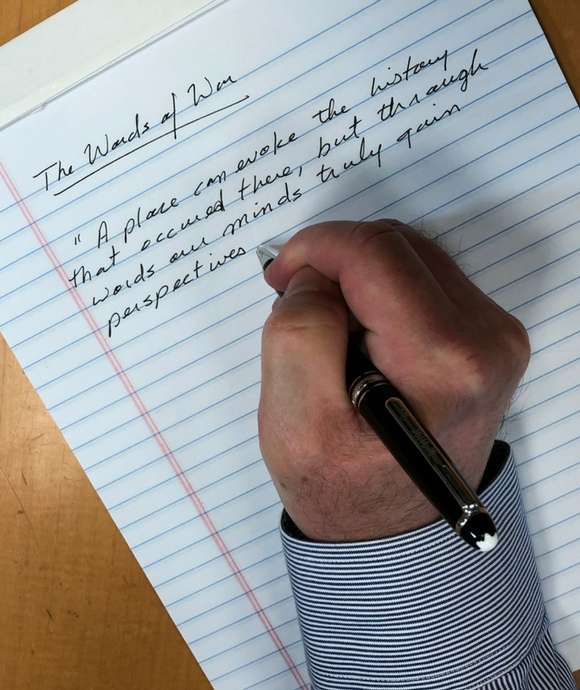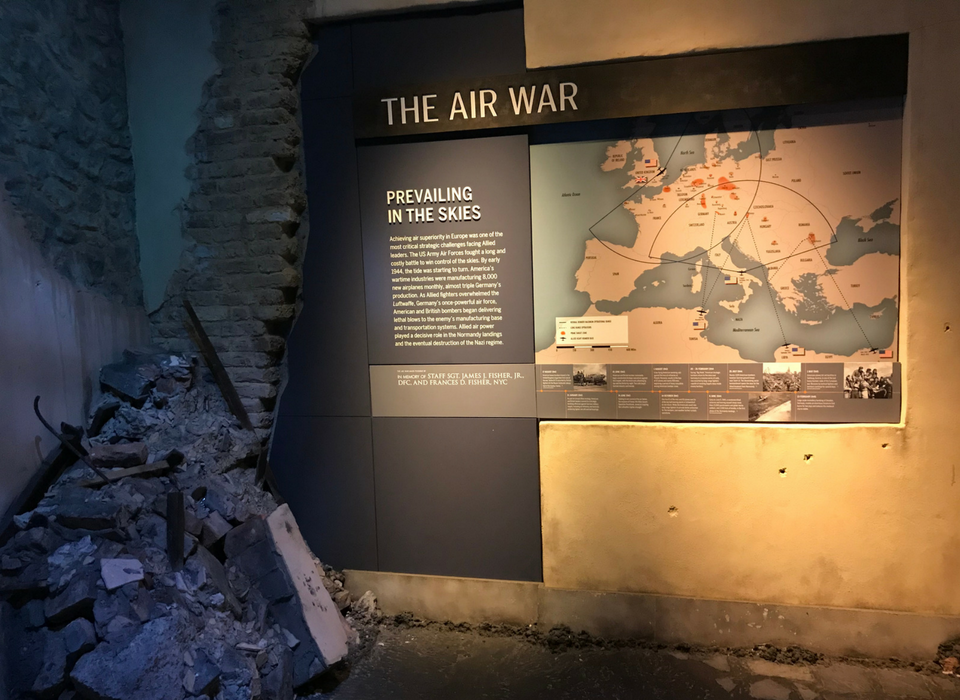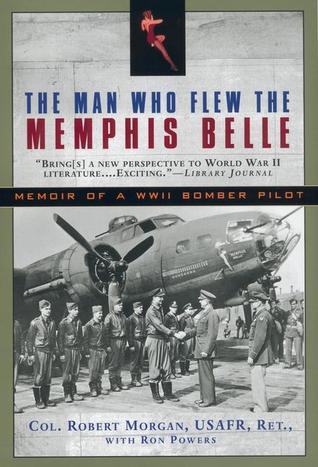Top Image: The "Air War" gallery at The National WWII Museum.
“We walked across the tarmac toward the popping flashbulbs and the screaming, waving crowd that had come to see us, toward a world as unreal in its own way as the world of stratospheric combat we had just left behind. It was a world filled with luncheons on fine crystal and linen and microphones on platforms draped in patriotic bunting. A world of people who wanted to touch us, tell us their names, hear our quotes, have us sign pieces of paper. A world of sleek-looking men and women who smelled of hair tonic and perfume and had happy, excited faces, faces that didn’t look as though they’d ever seen violent death. A world of young women in pretty hats and nylons and high heels, who looked at us the same way Teresa Wright had looked at her young airman boyfriend in Mrs. Miniver.
“A world that spoke of us as heroes.
"Heroes.
“That word again. Was it really us they were talking about? We asked one another that question a lot during the tumult of the next few months. The word felt like a suit of clothes that didn’t quite fit. We talked it over among ourselves, and we agreed. ‘Hero’ was not a label any of us felt comfortable wearing.
“We weren’t heroes. We were just . . . us, a unit of military men who’d been given a job to do and who tried to do it well. We were lucky, that much was sure. We were alive. We lived with our memories of brave men, buddies of ours, who weren’t, or whose fates were as yet unknown. Men whose parachutes we’d seen open, or fail to open, when their planes were shot to pieces. Men who’d kept focused on their bombing runs after taking hits they knew they would never survive. Men who steered their planes out of formation to try and protect a damaged ship. Weren’t they the heroes? We were simply young men who flew bombing missions and played poker and looked out for each other and maybe drank too much and chased too many women sometimes, but who had dreams of coming home and resuming decent, ordinary lives.
“Hell, wasn’t that enough?”
Col. Robert K. Morgan, The Man Who Flew the Memphis Belle: Memoir of a WWII Bomber Pilot, p. 220-221.
This passage makes a tremendous impression because it is the first time a crew from the Eighth Air Force fighting against the Luftwaffe over Europe had survived 25 missions and returned home, arriving to a tumultuous celebration and happy people—yet the young men in the ordeal have not left the war behind.
As the young pilot of the Memphis Belle notes, they had exited one incredible world of combat that was virtually unrecognizable to anyone who had not experienced it into another, almost equally strange realm: celebrity. Captain Robert K. Morgan was looking forward to reuniting with his girlfriend, Margaret Polk of Memphis, Tennessee, whose picture taped in the cockpit of the plane had guided him back to her, to home, to safety, and to a new life. But he had not returned to peace.
A reader can immediately sense that the transition ahead of Morgan and his crew will be something for which none of them are really prepared. The American government and press clearly want to promote the story of the Memphis Belle crew, publicize their survival to rally support for the war, sell war bonds, and use their example as proof that progress is being made in the war. These young men will find themselves respected by older men who want to buy drinks for them, respected and envied by young men who want to be them, and they will receive the flattering attention of young women who want to be with them. Propelling the media frenzy to even greater heights will be the film made by Oscar-winning Hollywood director William Wyler, who flew with Morgan and the crew of the Memphis Belle over Europe, and whose footage would give Americans at home a view into the world of combat against which these young men had prevailed.
But just as they had to rely on each other to survive in the skies over Europe, the crew of the Memphis Belle now had to support each other when faced with this new world of celebrity, because between themselves they knew something that their admirers did not: They had survived and come back from violent death, but they carried the war within them, because they have seen the faces of comrades who did not return. They had sat in mess halls with seats empty from the previous morning’s breakfast, drank in bars where faces were missing from the evening before, seen planes filled with crews just like their own fall from the skies, sometimes in sudden, violent explosions and sometimes in long, aching descents that hid the ultimate fate of their comrades from view.
They were not comfortable being called heroes, when they personally knew young men like themselves who had made the ultimate sacrifice. They could not think of themselves as heroes, not when a war was still going on. As Morgan writes, they were ready to lead decent, ordinary lives.
But as Morgan himself would find, they could not—not while a war was still going on. The demands and pressures of publicity would prevent Morgan and Margaret Polk from securing their relationship in marriage. Instead, he would marry another woman, seeking the happiness and normal life that he believed he wanted and had earned. But even at that point, the war was still not yet done with Robert Morgan and millions of other young men like him, and the omnipresence of the war in his life will be the subject of my next post.
This is the second of three posts on Morgan's memoirs. Read Part One. Part Three.

“A place can evoke the history that occurred there, but through words our minds truly gain perspectives and understanding of what it was like to know, feel, experience, hope, fail, triumph, and live through events from which we ourselves were absent. The written word is our most intricate map to retrace and reconstruct what we think happened, and ultimately brings us back to ourselves.”
– Keith Huxen, PhD , Senior Director of Research and History, The National WWII Museum
Keith Huxen
Keith is the former Senior Director of Research and History in the Institute for the Study of War and Democracy at The National WWII Museum.
Cite this article:
MLA Citation:
APA Citation:
Chicago Style Citation:






![Max Fuchs, New York City cantor, sings as Rabbi Sydney [sic] Lefkowitz, Richmond, VA, conducts the first Jewish services from Germany.](/sites/default/files/styles/max_650x650/public/2025-10/image1.jpg)



